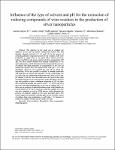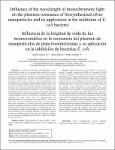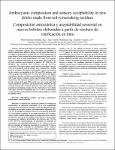Mostrar el registro sencillo del ítem
Effect of time on the reducing capacity of wine residue extracts: Applicability in the biosynthesis of silver nanoparticles [Efecto del tiempo en la capacidad reductora de extractos de residuos vinícolas: Aplicabilidad en la biosíntesis de nanopartículas de plata]
| dc.contributor.author | Asmat-Campos, David | |
| dc.contributor.author | Vejarano Mantilla, David | |
| dc.contributor.author | Mercedes-Cárdenas, Santos | |
| dc.contributor.author | Cadillo-Solano, Annel | |
| dc.contributor.author | Juárez-Cortijo, Luisa | |
| dc.contributor.author | Delfín-Narciso, Daniel | |
| dc.contributor.author | Rengifo-Penadillos, Roger | |
| dc.contributor.author | Siche-Jara, Raúl | |
| dc.date.accessioned | 2021-09-28T22:40:55Z | |
| dc.date.available | 2021-09-28T22:40:55Z | |
| dc.date.issued | 2020-09-15 | |
| dc.identifier.citation | Asmat, D., ...[et al.]. (2020). Effect of time on the reducing capacity of wine residue extracts: Applicability in the biosynthesis of silver nanoparticles [Efecto del tiempo en la capacidad reductora de extractos de residuos vinícolas: Aplicabilidad en la biosíntesis de nanopartículas de plata].Proceedings of the LACCEI International Multi-conference for Engineering, Education and Technology, 2020(202). http://dx.doi.org/10.18687/LACCEI2020.1.1.202 | es_PE |
| dc.identifier.uri | https://hdl.handle.net/11537/28000 | |
| dc.description.abstract | RESUMEN En el sector agroindustrial la materia prima es sometida a procesos de transformación para otorgarle un valor agregado, para ello se implementa diversas metodologías las cuales facilitan sus consumos, pero los residuos vinícolas por el contrario generan una de las principales problemáticas ambientales. Esta investigación adopta el estudio de la influencia del tiempo de reposo del extracto en solvente alcohólico (96%) de residuos provenientes de la producción vinícola, evaluándose la concentración de los compuestos fenólicos por alrededor de 114 días (un total de seis datos) y a su vez se sintetizaron nanopartículas de plata (NP Ag) por el método de química verde (biosíntesis) evaluándose también el potencial reductor del extracto respecto del precursor AgNO3 para la formación de NP Ag. La evaluación del extracto fue mediante la cuantificación del contenido de polifenoles por el método de FollinCiocalteu. Se realizó análisis por FTIR (Espectroscopía infrarroja por transformada de Fourier) únicamente a la muestra inicial para su evaluación comparativa entre extracto alcohólico de residuos vinícolas y NP Ag; las NP Ag fueron caracterizadas por espectrofotometría UV-Vis.(Ultravioleta-visible) Los resultados sugieren que a pesar de que el contenido de compuestos fenólicos se vea reducido en el tiempo, hay hipótesis que consideran un comportamiento constante y hasta incluso un incremento de la capacidad reductoras. Es así como los resultados por espectrofotometría de las NP Ag evidencian un incremento del pico de absorbancia que implica una mayor producción de nanoestructuras, siendo los antioxidantes los implicados en el proceso de reducción química. | es_PE |
| dc.description.abstract | ABSTRACT In the agribusiness sector, the raw material is subjected to transformation processes to give it added value, for this purpose various methodologies are implemented which facilitate its consumption, but wine residues on the contrary generate one of the main environmental problems. This research adopts the study of the influence of the resting time of the extract in alcoholic solvent (96%) of residues from wine production, evaluating the concentration of phenolic compounds for about 114 days (a total of six data) and their once silver nanoparticles (NP Ag) were synthesized by the green chemistry method (biosynthesis), also evaluating the reducing potential of the extract with respect to the AgNO3 precursor for the formation of NP Ag. The evaluation of the extract was by quantifying the polyphenol content by the Follin-Ciocalteu method. FTIR (Fourier transform infrared spectroscopy) analysis was performed only to the initial sample for comparative evaluation between alcoholic extract of wine residues and NP Ag; NP Ag were characterized by UV-Vis spectrophotometry (Ultraviolet-visible). The results suggest that despite the fact that the content of phenolic compounds is reduced over time, there are hypotheses that consider a constant behavior and even an increase in reducing capacity. This is how the results by spectrophotometry of NP Ag show a increase in absorbance peak that implies a greater production of nanostructures, with antioxidants being the ones involved in the chemical reduction process. | es_PE |
| dc.format | application/pdf | es_PE |
| dc.language.iso | spa | es_PE |
| dc.publisher | LACCEI | es_PE |
| dc.rights | info:eu-repo/semantics/openAccess | es_PE |
| dc.rights | Atribución-NoComercial-CompartirIgual 3.0 Estados Unidos de América | * |
| dc.rights.uri | https://creativecommons.org/licenses/by-nc-sa/3.0/us/ | * |
| dc.source | Universidad Privada del Norte | es_PE |
| dc.source | Repositorio Institucional - UPN | es_PE |
| dc.subject | Uvas | es_PE |
| dc.subject | Residuos | es_PE |
| dc.subject | Antioxidantes | es_PE |
| dc.subject | Industria vitivinicola | es_PE |
| dc.title | Effect of time on the reducing capacity of wine residue extracts: Applicability in the biosynthesis of silver nanoparticles [Efecto del tiempo en la capacidad reductora de extractos de residuos vinícolas: Aplicabilidad en la biosíntesis de nanopartículas de plata] | es_PE |
| dc.type | info:eu-repo/semantics/conferenceObject | es_PE |
| dc.publisher.country | CO | es_PE |
| dc.identifier.journal | Proceedings of the LACCEI International Multi-conference for Engineering, Education and Technology | es_PE |
| dc.description.peer-review | Revisión por pares | es_PE |
| dc.subject.ocde | https://purl.org/pe-repo/ocde/ford#2.11.00 | es_PE |
| dc.description.sede | Trujillo San Isidro | es_PE |
| dc.identifier.doi | http://dx.doi.org/10.18687/LACCEI2020.1.1.202 |







